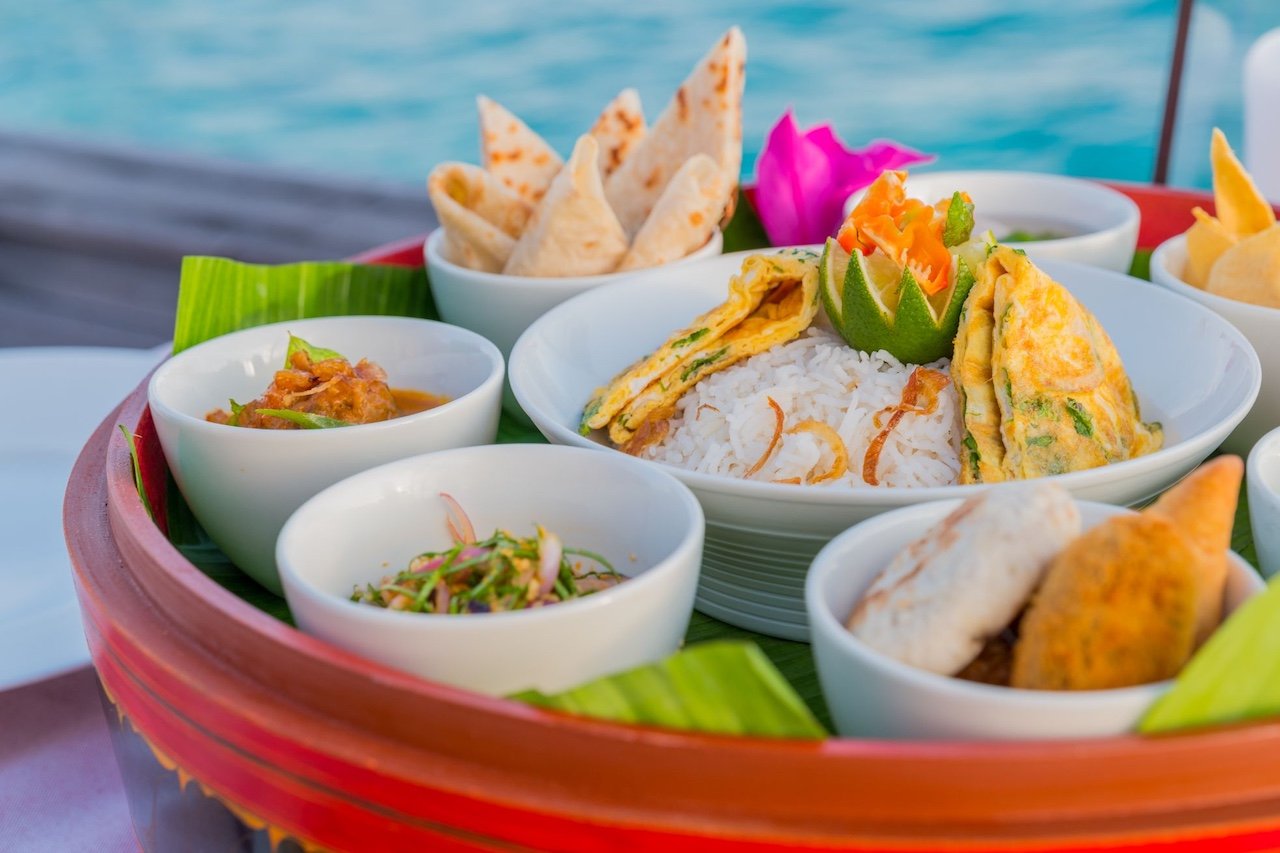Traditional Maldivian Food Guide: What to Try (2025) – Standing in the bustling streets of Male’s local market, I was immediately struck by the intoxicating aromas of fresh coconut, curry leaves, and smoking tuna! That moment marked the beginning of my deep dive into traditional Maldivian cuisine, and what a journey it’s been. After spending countless hours exploring local cafes, learning from home cooks, and even attempting to master some dishes myself, I’m excited to share everything I’ve discovered about this incredible cuisine.
Did you know that the Maldives has been a crucial stop on ancient trade routes for over 2,500 years? This historical significance has profoundly influenced their culinary traditions, creating a unique fusion of flavors from across the Indian Ocean. According to the Maldives Cultural Department, some traditional recipes have remained virtually unchanged for centuries!
Essential Maldivian Breakfast Dishes
My first experience with a traditional Maldivian breakfast completely changed my perspective on morning meals. Imagine starting your day with flavors so vibrant they wake up every taste bud! The star of every Maldivian breakfast table is mas huni, a dish that perfectly encapsulates the essence of Maldivian cuisine.
Mas huni combines shredded smoked tuna, freshly grated coconut, diced onions, and a hint of chili. The proportion is crucial – equal parts tuna and coconut, with just enough onion to add crunch and chili for a gentle kick. This mixture is traditionally served with roshi, a flatbread similar to Indian chapati but with its own distinct character.
One morning, while enjoying breakfast at a local cafe in Male, I watched in fascination as regulars expertly scooped up their mas huni using pieces of roshi. There’s definitely a technique to it! You tear off a small piece of roshi, create a little pocket, and use it to scoop up the perfect amount of mas huni. Trust me, it tastes better this way than with a fork – I learned that lesson the hard way!

Must-Try Maldivian Curries and Main Dishes
The heart of Maldivian cuisine lies in its incredible curries. Mas riha (tuna curry) isn’t just another dish – it’s the national dish of the Maldives! This curry perfectly represents the Maldivian approach to cooking: fresh ingredients, aromatic spices, and techniques perfected over generations.
The key to an authentic mas riha lies in the blend of spices and the quality of the tuna. Fresh yellowfin tuna is preferred, and the curry paste typically includes cumin, coriander, cinnamon, black pepper, and curry leaves. The addition of fresh coconut milk creates a rich, creamy sauce that’s absolutely divine with steamed rice.
During my stay on a local island, I was fortunate enough to learn the traditional way of preparing kukulhu riha (chicken curry). The process begins with roasting whole spices until they release their oils – a step that many modern preparations skip but makes a world of difference to the final flavor. Local cooks insist on using fresh coconuts, grated and squeezed by hand, rather than canned coconut milk.

Local Seafood Specialties
Being an island nation, it’s no surprise that seafood plays a starring role in Maldivian cuisine. What might surprise you is the incredible variety of preparations and the sophisticated understanding of seafood cooking that local chefs possess.
Garudhiya, a clear fish broth, might seem simple but don’t be fooled! This dish requires precise timing and technique to achieve its perfect balance of flavors. The broth is made by slowly cooking fresh tuna in water with just a touch of salt, allowing the natural flavors of the fish to shine. It’s typically served with lime, chili, and rice, creating a light but satisfying meal that’s especially popular during warmer months.
The grilled fish (fihunu mas) preparation here is unlike anything I’ve tasted elsewhere. The fish is scored and then rubbed with a paste made from local spices, including peppercorns, cumin, and chili. What makes it unique is the addition of grated fresh coconut to the marinade, which helps create a beautifully caramelized crust during grilling.

Vegetable and Side Dishes
While seafood dominates Maldivian cuisine, the vegetable dishes deserve special attention. Taro curry (ala riha) showcases the islands’ ability to transform simple root vegetables into something extraordinary. The taro is carefully cubed and cooked in a fragrant curry sauce that typically includes curry leaves, pandan, and fresh coconut milk.
One of my favorite discoveries was the banana flower curry. The preparation is quite labor-intensive – the flower needs to be carefully cleaned and cut to remove any bitter elements. But the result is a uniquely textured dish with a subtle flavor that pairs beautifully with spicier curries.
The humble coconut appears in almost every meal, and coconut sambal is a constant presence on Maldivian tables. This condiment combines freshly grated coconut with onions, chili, and lime juice, creating a fresh, zesty accompaniment that brightens up any dish.

Traditional Snacks and Street Food
The world of Maldivian hedhikaa (short eats or snacks) is a treasure trove of flavors! These small bites are typically enjoyed in the late afternoon with tea, creating a social atmosphere similar to British tea time but with distinctly Maldivian flavors.
Gulha, small fish-filled dumplings, quickly became my favorite afternoon snack. The outer shell is made from a dough of flour, grated coconut, and water, while the filling combines smoked tuna, curry leaves, and spices. The trick to perfect gulha, as I learned in a cooking class, is getting the right thickness for the outer shell – too thick and it becomes stodgy, too thin and it breaks during frying.
Masroshi, a type of stuffed flatbread, showcases the Maldivian talent for combining simple ingredients into something spectacular. The bread is filled with a spiced tuna mixture, then folded and cooked until golden brown. It’s particularly popular during Ramadan but can be found year-round in local cafes.

Sweet Treats and Desserts
Maldivian desserts offer a fascinating glimpse into local ingredients and cooking techniques. Bondi cake, a traditional celebration cake, reflects both local tastes and foreign influences. It’s made with rice flour, coconut milk, and palm sugar, then topped with pandan-flavored cream.
The finger millet pudding was a revelation – smooth, not too sweet, and flavored with cardamom and coconut milk. This ancient recipe has survived centuries because it’s just that good! Local cooks still prepare it the traditional way, stirring constantly over low heat until it reaches the perfect consistency.
Beverages and Refreshments
No meal is complete without traditional beverages, and the Maldives offers some unique options. Fresh coconut water is available everywhere, but there’s an art to choosing the right coconut for different times of day. Young coconuts provide refreshing, sweet water perfect for hot afternoons, while mature coconuts offer a richer, more complex flavor.
Raa, or palm nectar, deserves special mention. This traditional drink is collected from palm trees early in the morning and must be consumed fresh. It’s naturally sweet when first collected but ferments quickly in the tropical heat, creating a slightly fizzy beverage by afternoon.

Where to Find Traditional Maldivian Food
For the most authentic food experiences, I recommend exploring the local islands rather than limiting yourself to resort restaurants. In Male, the area around the local market is a food lover’s paradise. Small restaurants and cafes serve traditional dishes throughout the day, often specializing in specific items.
Don’t miss the northern end of Male’s market, where you’ll find vendors selling fresh mas huni and roshi in the morning. Around 4 PM, the same area comes alive with hedhikaa vendors offering an amazing variety of snacks.
On local islands, look for small family-run restaurants, often attached to guesthouses. These places typically serve set meals at specific times, offering a true taste of home-style Maldivian cooking.
Conclusion
Traditional Maldivian cuisine is a beautiful reflection of the islands’ history, culture, and natural resources. From the morning ritual of preparing mas huni to the complex spice blends of curry dishes, each recipe tells a story of tradition and innovation. Whether you’re staying in a luxury resort or exploring local islands, make sure to venture beyond international cuisine and discover these authentic flavors.
Remember, the best food experiences often come with a side of cultural exchange. Don’t be shy about asking questions – Maldivians are generally delighted to share their culinary knowledge with interested visitors. And while some dishes might seem unfamiliar at first, approaching them with an open mind will reward you with unforgettable flavors and a deeper understanding of these remarkable islands.
Frequently Asked Questions About Maldivian Food
Is Maldivian food spicy?
Maldivian cuisine has a moderate spice level that varies by dish and preparation. While many dishes incorporate chilies and black pepper, they’re typically not overwhelmingly hot. Most restaurants and home cooks can adjust the spice level to your preference. Traditional dishes like mas huni and tuna curry have a pleasant warmth rather than intense heat. If you’re sensitive to spice, simply request “less spicy” or “no chili” when ordering.
What can vegetarians eat in the Maldives?
While Maldivian cuisine is heavily focused on seafood, there are several vegetarian options available. Traditional vegetable curries like taro curry (ala riha) and pumpkin curry are completely vegetarian. You’ll also find breadfruit dishes, coconut-based sides, and various vegetable preparations. Many restaurants, especially in tourist areas, now offer vegetarian versions of traditional dishes. However, it’s important to note that even vegetable dishes might be prepared with fish-based broth (garudhiya), so be sure to specify your dietary requirements when ordering.
What’s the best time of day to try local Maldivian food?
For the most authentic experience, start early! Traditional breakfast items like mas huni are typically served between 6:30 AM and 9:00 AM. Local cafes serve lunch from 12:30 PM to 2:00 PM, offering the best selection of curries and rice dishes. Don’t miss the afternoon short eats (hedhikaa) served around 4:00 PM – this is when you’ll find the freshest selection of traditional snacks. Many local restaurants serve dinner from 6:30 PM onwards, though some might close earlier than you’d expect.
Where can I find authentic Maldivian food if I’m staying at a resort?
While resorts often focus on international cuisine, many now offer authentic Maldivian options. Look for special “Maldivian Nights” at resort restaurants, which typically feature traditional dishes. Better yet, arrange a day trip to a nearby local island where you can experience genuine local cafes. Some resorts also offer Maldivian cooking classes or cultural dining experiences. Don’t hesitate to ask your resort’s staff for recommendations – they often know the best spots for authentic local food.
Is it safe to eat local food in the Maldives?
Yes, it’s generally very safe to eat local food in the Maldives. The country has good food safety standards, and most establishments maintain clean cooking environments. Fresh seafood is caught daily, and coconuts are harvested as needed. When eating at local islands, stick to busy restaurants with high turnover – this ensures the food is fresh. As with any tropical destination, it’s wise to drink bottled water and ensure any fresh fruits and vegetables are properly cleaned. Most stomach issues travelers experience are more often related to adjusting to new spices rather than food safety concerns.





